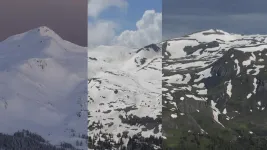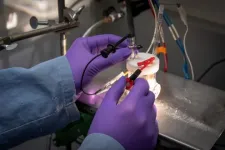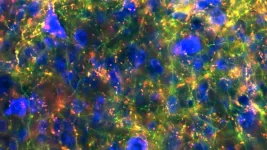(Press-News.org) Irvine, Calif. -- In 2019, the National Weather Service in Alaska reported spotting the first-known lightning strikes within 300 miles of the North Pole. Lightning strikes are almost unheard of above the Arctic Circle, but scientists led by researchers at the University of California, Irvine have published new research in the journal Nature Climate Change detailing how Arctic lightning strikes stand to increase by about 100 percent over northern lands by the end of the century as the climate continues warming.
"We projected how lightning in high-latitude boreal forests and Arctic tundra regions will change across North America and Eurasia," said Yang Chen, a research scientist in the UCI Department of Earth System Science who led the new work. "The size of the lightning response surprised us because expected changes at mid-latitudes are much smaller."
The finding offers a glimpse into the changes that're in store for the Arctic as the planet continues warming; it suggests Arctic weather reports during summertime will be closer to those seen today far to the south, where lightning storms are more common.
James Randerson, a professor in UCI's Department of Earth System Science who co-authored the study, was part of a NASA-led field campaign that studied wildfire occurrence in Alaska during 2015, which was a extreme year for wildfires in the state. "2015 was an exceptional fire year because of a record number of fire starts," Randerson said. "One thing that got us thinking was that lightning was responsible for the record-breaking number of fires."
This led Chen to look at over-twenty-year-old NASA satellite data on lighting strikes in northern regions, and construct a relationship between the flash rate and climatic factors. By using future climate projections from multiple models used by the United Nations, the team estimated a significant increase in lightning strikes as a result of increases in atmospheric convection and more intense thunderstorms.
A lightning strike bump could open a Pandora's box of related troubles. Fires, Randerson explained, burn away short grasses, mosses, and shrubs that are important components of Arctic tundra ecosystems. Such plants cover much of the landscape, and one thing they do is keep the seeds of trees from taking root in the soil. After a fire burns away low-lying plants, however, seeds from trees can more easily grow on bare soil, allowing forests stands to expand north. Evergreen forests will replace what's typically a snow-covered landscape; snow's white hue reflects sunlight back out into space, but darker forests absorb solar energy, helping warm the region even further.
And there's more trouble: more fires mean more permafrost -- perennially frozen soil that defines much of the Arctic landscape -- will melt as the fires strip away protective insulative layers of moss and dead organic matter that keep soils cool. Permafrost stores a lot of organic carbon that, if melted out of the ice, will convert to greenhouse gases carbon dioxide and methane, which, when released, will drive even more warming.
The lighting finding comes of the heels of another study that, led by Randerson, published in the Journal of Geophysical Research on Monday, April 5 describes how amplified Arctic warming and the melting of the Greenland ice sheet will scramble food webs in the surrounding oceans.
Now, Chen and Randerson say, scientists need to start paying more attention to the frequency of Arctic lightning strikes so they can gauge how the story unfolds in the coming decades.
"This phenomenon is very sporadic, and it's very difficult to measure accurately over long time periods," said Randerson. "It's so rare to have lightning above the Arctic Circle." Their results, he hopes, will galvanize calls for new satellite missions that can monitor Arctic and boreal latitudes for lightning strikes and the fires they might ignite.
Back in 2019, the National Weather Service in Alaska released a special announcement about the North Pole lightning strikes. Such announcements, however, may struggle to make headlines by the end of the century.
INFORMATION:
This work, funded by the U.S. Department of Energy Office of Science, NASA's Interdisciplinary Science and Carbon Monitoring System programs, and DOE's Next Generation Ecosystem Experiment Arctic project, includes researchers from the University of California, Berkeley; Lawrence Berkeley National Laboratory; Harvard University and Vrije Universiteit Amsterdam.
About the University of California, Irvine: Founded in 1965, UCI is the youngest member of the prestigious Association of American Universities. The campus has produced three Nobel laureates and is known for its academic achievement, premier research, innovation and anteater mascot. Led by Chancellor Howard Gillman, UCI has more than 36,000 students and offers 222 degree programs. It's located in one of the world's safest and most economically vibrant communities and is Orange County's second-largest employer, contributing $5 billion annually to the local economy. For more on UCI, visit http://www.uci.edu.
Media access: Radio programs/stations may, for a fee, use an on-campus ISDN line to interview UCI faculty and experts, subject to availability and university approval. For more UCI news, visit news.uci.edu. Additional resources for journalists may be found at communications.uci.edu/for-journalists.
An interdisciplinary team led by KU Leuven and Stanford has identified 76 overlapping genetic locations that shape both our face and our brain. What the researchers didn't find is evidence that this genetic overlap also predicts someone's behavioural-cognitive traits or risk of conditions such as Alzheimer's disease. This means that the findings help to debunk several persistent pseudoscientific claims about what our face reveals about us.
There were already indications of a genetic link between the shape of our face and that of our brain, says Professor Peter Claes from the Laboratory for Imaging Genetics at KU Leuven, who is the joint senior author of the study with Professor Joanna Wysocka from the ...
Journal Name: Nature Methods
Title of the Article: Discovering multiple types of DNA methylation from individual bacteria and microbiome using nanopore sequencing
Corresponding Author: Gang Fang, PhD
Bottom Line:
Bacterial DNA methylation occurs at diverse sequence contexts and plays important functional roles in cellular defense and gene regulation. An increasing number of studies have reported that bacterial DNA methylation has important roles affecting clinically relevant phenotypes such as virulence, host colonization, sporulation, biofilm formation, among others.
Bacterial methylomes contain three ...
What The Study Did: A clinical risk assessment tool developed in China was tested with a group of patients in Spain to evaluate its ability to predict critical illness among patients hospitalized with COVID-19 in Europe.
Authors: Oscar Moreno-Perez, M.D., Ph.D., of the Alicante General University Hospital-Alicante Institute of Sanitary and Biomedical Research in Alicante, Spain, is the corresponding author.
To access the embargoed study: Visit our For The Media website at this link https://media.jamanetwork.com/
(doi:10.1001/jamainternmed.2021.0491)
Editor's Note: The article includes conflicts of interest disclosures. Please see the article for additional information, including other authors, author contributions and affiliations, conflict of interest and financial disclosures, and ...
What The Study Did: The 30-day incidence of outpatient and hospital-associated blood clots following SARS-CoV-2 testing among adults in a large health system was examined in this study.
Authors: Nareg H. Roubinian, M.D., of Kaiser Permanente Northern California in Oakland, is the corresponding author.
To access the embargoed study: Visit our For The Media website at this link https://media.jamanetwork.com/
(doi:10.1001/jamainternmed.2021.0488)
Editor's Note: The article includes conflicts of interest and funding/support disclosures. Please see the article for additional information, ...
What The Study Did: Researchers investigated the association of sociodemographic factors and blood group type with the risk of SARS-CoV-2 infection and severity of COVID-19.
Authors: Jeffrey L. Anderson, M.D., of the Intermountain Medical Center Heart Institute in Salt Lake City, is the corresponding author.
To access the embargoed study: Visit our For The Media website at this link https://media.jamanetwork.com/
(doi:10.1001/jamanetworkopen.2021.7429)
Editor's Note: The article includes conflicts of interest disclosures. Please see the ...
What The Study Did: Electronic health record data were used to examine whether the transition to remote cardiology clinic visits during COVID-19 is associated with disparities in patient use of care, diagnostic test ordering and medication prescribing.
Authors: Neal Yuan, M.D., of Cedars-Sinai Medical Center in Los Angeles, is the corresponding author.
To access the embargoed study: Visit our For The Media website at this link https://media.jamanetwork.com/
(doi:10.1001/jamanetworkopen.2021.4157)
Editor's Note: The article includes conflicts of interest and funding/support disclosures. Please see the article for additional information, including other authors, author ...
More snow is melting during winter across the West, a concerning trend that could impact everything from ski conditions to fire danger and agriculture, according to a new University of Colorado Boulder analysis of 40 years of data.
Researchers found that since the late 1970s, winter's boundary with spring has been slowly disappearing, with one-third of 1,065 snow measurement stations from the Mexican border to the Alaskan Arctic recording increasing winter snowmelt. While stations with significant melt increases have recorded them mostly in November and March, the researchers found that melt is increasing in all cold season ...
Three years ago, scientists at the University of Michigan discovered an artificial photosynthesis device made of silicon and gallium nitride (Si/GaN) that harnesses sunlight into carbon-free hydrogen for fuel cells with twice the efficiency and stability of some previous technologies.
Now, scientists at the Department of Energy's (DOE's) Lawrence Berkeley National Laboratory (Berkeley Lab) - in collaboration with the University of Michigan and Lawrence Livermore National Laboratory (LLNL) - have uncovered a surprising, self-improving property in Si/GaN that contributes to the material's highly efficient and stable performance ...
Thousands of our daily activities, from making coffee to taking a walk to saying hello to a neighbor, are made possible through an ancient collection of brain structures tucked away near the center of the cranium.
The cluster of neurons known as the basal ganglia is a central hub for regulating a vast array of routine motor and behavior functions. But when signaling in the basal ganglia is weakened or broken, debilitating movement and psychiatric disorders can emerge, including Parkinson's disease, Tourette's syndrome, attention deficit hyperactivity disorder (ADHD) and obsessive-compulsive ...
Alzheimer's disease treatments that slow progression of the disease could significantly reduce the financial burden to U.S. state budgets, according to a new USC study.
The study outlines how states -- which have been hit particularly hard by the COVID-19 pandemic -- would see relief: Medicare would cover the costs of treating the disease, while Medicaid expenditures would be reduced due to fewer patients entering nursing homes.
Assuming a 40% relative reduction of Alzheimer's disease progression rates with treatment, researchers projected two decades of savings beginning in 2021, using a simulation model of state Medicaid programs. They forecast annual savings for Medicaid programs of $7.4 billion in 2030; by 2040, the annual savings would be more than $22 billion.
All ...



